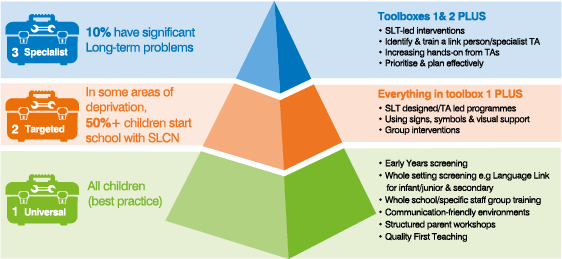The following information won’t come as a shock; it’s depressingly familiar in fact.
- The majority of pupils with SEN have Speech, Language and/or Communication Needs (SLCN)
- Language disorders are 7 times more prevalent than other developmental conditions such as autism
- In areas of deprivation more than 50% of children start school with delayed Speech and Language
- Children with SLCN start school without the language they need in order to learn and are disadvantaged from the start
- Between 50% and 90% of pupils with SLCN have problems learning to read
- Children need language to learn, socialise, manage their behaviour and develop emotionally
- There’s a gap of 41% between the attainment at GCSE of Pupils with SLCN and those without
Most NHS Speech and Language Therapy (SLT) Services have to ration what they provide – it’s a fact of life, and one we have all become used to. Schools are left to manage the impact of SLCN with ever decreasing resources.
Head teachers and SENCOs are left wondering how best to manage the impact of SLCN within their over stretched and often decreasing resources.
Prevention & Intervention
Raise attainment by taking ownership of speech and language development from the start

The answer could be to commission your own SLT service.
First decide on your objectives (short, medium and longer term if that helps). SLT can get you underway and ‘hand hold’ for a while, coming back later to monitor progress and move you on.
Ideally your service should include both Prevention & Intervention.
Aim to commission a service which includes something from all 3 of the tiers and supports the requirement for a graduated response to SEND.
Universal activities should include screening tools such as Language Link: identify problems early, know what action to take before children start to fall behind, and ensure good practice supports the language development of all children.
For example, basic training and awareness-raising at tier 1 means
- staff understand the nature of SLCN and the impact of their own language styles on successful teaching and learning
- successful and consistent use of visual support across the school – that helps everyone, including those with SEN, behaviour difficulties & EAL.
Targeted interventions at tier 2 can include individual assessments, intervention groups, and targeted training of TAs who will support this work.
The specialist skills of the therapist should be used at tier 3 for the most needy, those who really need individual support.
Key points to consider
- What’s the budget? Often phased delivery can be a good plan, allowing you to spend your budget as your needs dictate
- Shop around – there’s a bigger choice of providers than ever before, and ask for consultation visit to talk about what the service can offer you
- With colleagues, discuss what you want but talk it through with the therapy service – they will guide you and may have alternative options for you to consider
- Use the Toolbox model to map what you already have and to identify gaps
- What training would help, who needs it, and how will the learning be shared?
Once you decide to take the plunge
- Ensure that the SLT always works with TAs who can begin to pick up hints and tips immediately- make the most of his/her time with you
- Consider a one-off package for a needs assessment + individual plans for children causing most concern – you may be surprised, not every child needs direct therapy and for those who do, deploy your TAs to best effect
- Explore creating specialist TA roles (training alongside the therapist- and/or via an external course)
- Make sure there are built in ways for you to evidence value for money and prove it was worth the investment
Monitoring the quality of the service – it’s not all about referrals and discharges
- Do you know what the therapist is doing when s/he comes into school?
- Do you decide priorities together?
- Do plans, programmes and interventions contribute to the impact statements you need?
- Is there a buzz from the TAs involved as they learn from working alongside the SLT?
- Is learning shared when TAs have received training?
- Are you sign-posted to resources and training?
- Are you exploiting the therapist’s skills at each of the 3 tiers?
- Are you using strategies from all 3 toolboxes?
- Is your progress towards the original objectives measurable?
![]()
Please login to view this content
Login